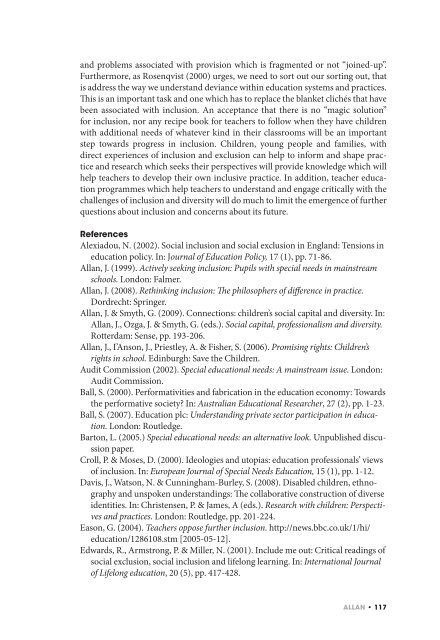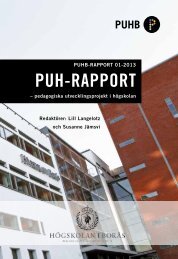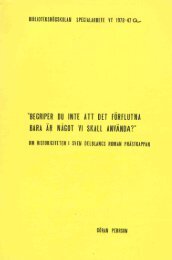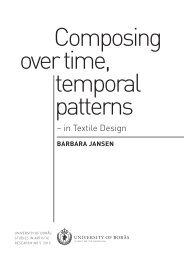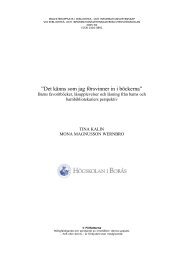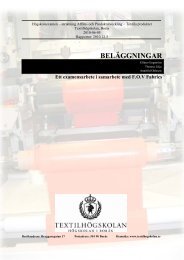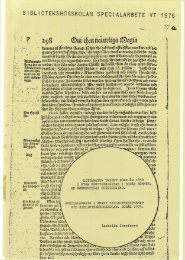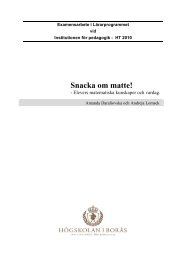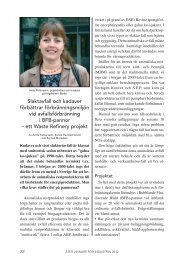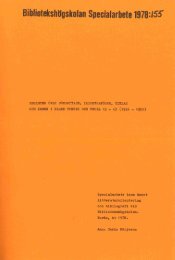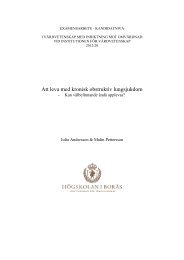Bildning för alla! - DiVA
Bildning för alla! - DiVA
Bildning för alla! - DiVA
Create successful ePaper yourself
Turn your PDF publications into a flip-book with our unique Google optimized e-Paper software.
and problems associated with provision which is fragmented or not “joined-up”.<br />
Furthermore, as Rosenqvist (2000) urges, we need to sort out our sorting out, that<br />
is address the way we understand deviance within education systems and practices.<br />
This is an important task and one which has to replace the blanket clichés that have<br />
been associated with inclusion. An acceptance that there is no “magic solution”<br />
for inclusion, nor any recipe book for teachers to follow when they have children<br />
with additional needs of whatever kind in their classrooms will be an important<br />
step towards progress in inclusion. Children, young people and families, with<br />
direct experiences of inclusion and exclusion can help to inform and shape practice<br />
and research which seeks their perspectives will provide knowledge which will<br />
help teachers to develop their own inclusive practice. In addition, teacher education<br />
programmes which help teachers to understand and engage critically with the<br />
challenges of inclusion and diversity will do much to limit the emergence of further<br />
questions about inclusion and concerns about its future.<br />
references<br />
Alexiadou, N. (2002). Social inclusion and social exclusion in England: Tensions in<br />
education policy. In: Journal of Education Policy, 17 (1), pp. 71-86.<br />
Allan, J. (1999). Actively seeking inclusion: Pupils with special needs in mainstream<br />
schools. London: Falmer.<br />
Allan, J. (2008). Rethinking inclusion: The philosophers of difference in practice.<br />
Dordrecht: Springer.<br />
Allan, J. & Smyth, G. (2009). Connections: children’s social capital and diversity. In:<br />
Allan, J., Ozga, J. & Smyth, G. (eds.). Social capital, professionalism and diversity.<br />
Rotterdam: Sense, pp. 193-206.<br />
Allan, J., I’Anson, J., Priestley, A. & Fisher, S. (2006). Promising rights: Children’s<br />
rights in school. Edinburgh: Save the Children.<br />
Audit Commission (2002). Special educational needs: A mainstream issue. London:<br />
Audit Commission.<br />
Ball, S. (2000). Performativities and fabrication in the education economy: Towards<br />
the performative society? In: Australian Educational Researcher, 27 (2), pp. 1-23.<br />
Ball, S. (2007). Education plc: Understanding private sector participation in education.<br />
London: Routledge.<br />
Barton, L. (2005.) Special educational needs: an alternative look. Unpublished discussion<br />
paper.<br />
Croll, P. & Moses, D. (2000). Ideologies and utopias: education professionals’ views<br />
of inclusion. In: European Journal of Special Needs Education, 15 (1), pp. 1-12.<br />
Davis, J., Watson, N. & Cunningham-Burley, S. (2008). Disabled children, ethnography<br />
and unspoken understandings: The collaborative construction of diverse<br />
identities. In: Christensen, P. & James, A (eds.). Research with children: Perspectives<br />
and practices. London: Routledge, pp. 201-224.<br />
Eason, G. (2004). Teachers oppose further inclusion. http://news.bbc.co.uk/1/hi/<br />
education/1286108.stm [2005-05-12].<br />
Edwards, R., Armstrong, P. & Miller, N. (2001). Include me out: Critical readings of<br />
social exclusion, social inclusion and lifelong learning. In: International Journal<br />
of Lifelong education, 20 (5), pp. 417-428.<br />
AllAn • 117


